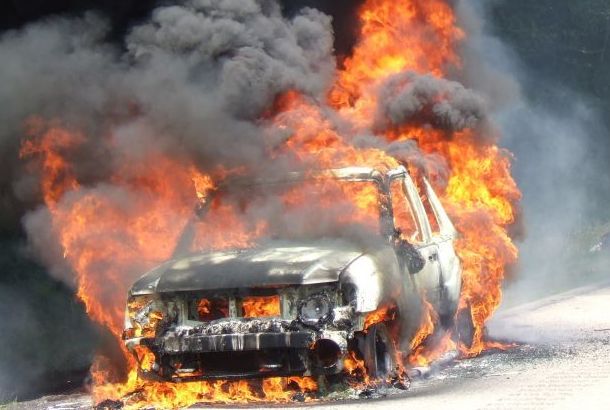
Article updated 6-June-2022
Vehicle fires are a burning issue in the UAE, literally. Especially in the hot summer months, we experience a series of vehicle fires.
Research indicates, that 75 percent of vehicle fires are caused by bad maintenance, mechanical or electrical failures or malfunctions. Collisions or overturns caused only 3% of these fires but 57% of the associated deaths. One-third of non-fatal vehicle fire injuries occurred when civilians attempted to fight the fire themselves.
UAE authorities also advise not to leave any inflammable objects (especially battery operated) and liquids in the vehicle. especially in summer. Related article we worked on with The National Newspaper in 2022 – click here!
Nature of the threat:
- The true danger are the toxic fumes, and shooting debris from parts of the vehicle which can burst because of heat. Explosions from car fires are rare.
- Vehicle fires usually progress slowly in the early stages, allowing occupants time to escape injury (except in case of collisions – see below).
- Most vehicle fires start in the engine compartment.
Preventing Vehicle Fires:
- VEHICLE MAINTENANCE and inspection IS CRUCIAL to prevent vehicle fires!!
- Watch for fluid leaks under vehicles, cracked or blistered hoses, or wiring that is loose, has exposed metal or has cracked insulation.
- Avoid throwing cigarette butts anywhere!
- When driving – Be alert to changes in the way your vehicle sounds when running, or to a visible plume of exhaust coming from the tailpipe. A louder than usual exhaust tone, smoke coming from the tailpipe or a backfiring exhaust could mean problems or damage to the high-temperature exhaust and emission control system on the vehicle.
- Make sure you don’t leave inflammable objects in your vehicle – especially in summer – like battery-operated devices (mobile phone, eCigarettes, eScooters, etc.), inflammable liquids (fuel, hand sanitizers, lighters etc.)
Advice when Vehicle is on Fire:
Escape from a burning car is a challenge that requires fast thinking and even faster acting.
- Stay as calm as you can. The worst possible thing that you can do is panic. Panic will cause you to waste precious seconds and make mistakes that could end up being tragic.
- If the vehicle is moving, signal and move to the side of the road.
- Get everyone to out of the vehicle safely.
- Turn off the ignition.
- Put the vehicle in park or set the emergency brake.
- Move at least 30 meters away. Keep traffic in mind and keep everyone together. There is not only danger from the fire, but also from other vehicles moving in the area.
- Warn oncoming traffic.
- Notify emergency services ‘999’ from a safe distance.
- Do not go back into a burning vehicle.
- Do not open the hood or trunk if you suspect a fire under it. Air could rush in, enlarging the fire leading to injury.
- Be cautious of attempting to put out the fire yourself –There is a risk of explosion and toxic fumes emanating from vehicles fires. Inhalation of toxic fumes is the most common form of fire-related death.
- If the fire is relatively small and in the interior, use your extinguisher. If there’s a small amount of smoke coming from under the hood, pop the release but don’t lift the hood. Quickly spray through the gap, from several feet away, aiming at the base of the fire rather than the flames
If in an accident and not possible to get out immediately:
- Unlock the doors and windows. Do whatever you can to accomplish this critical step.
- Even if you cannot open the door yourself, unlocking the doors will give bystanders or rescuers a good shot of getting you out of the burning vehicle quickly.
- Get your seat belt off.
- Kick out a window, if you cannot get the door open.
- Safety Tools to have on board in case of an accident:
- Fire Extinguisher.
- Emergency hammer/cutter: to cut windows with one strike, and to slash through jammed seat belts.
Source: https://www.arrivealive.co.za/Escape-and-Safety-from-Vehicle-Fire
Share your story









Recently, there was fire in a hired vehicle; the fire started at the front side; first smoke started coming out thro’ the AC openings; immediately all the travellers came out of the vehicle; subsequently, the entire vehicle was engulfed by fire. We are trying to find check points to prevent such accidents in future. This article provided useful tips.